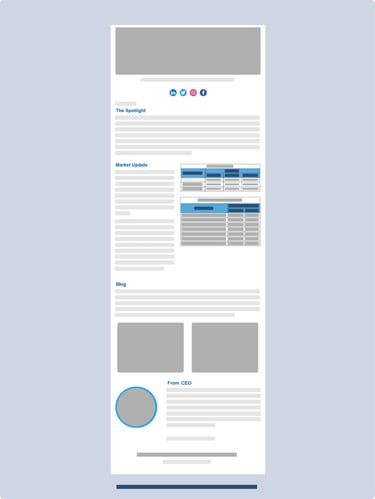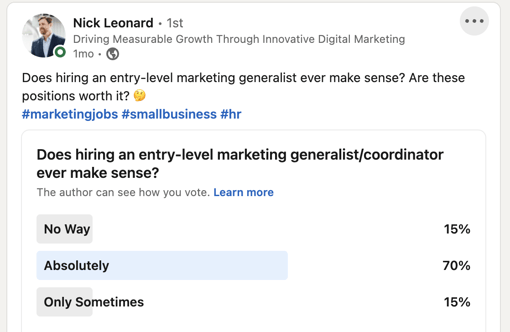
Looking Ahead - to Cut or Not to Cut?
While experts continue to dispute the state of the economy and how to define a recession, companies are deep into 2023 planning. What will the next year bring? Should you maintain, cut expenses, or plan for growth? Inflation moderated slightly over the summer, indicating that we may have passed the peak, but it’s still sky-high. Although this is not the time to make rash decisions, marketers should keep the future under scrutiny and forecast accordingly.
More often than not, the first expenses cut in times of a recession are marketing and advertising, as they are seen as discretionary costs. It may not be shocking that we’d beg to disagree. The second you cease marketing and advertising efforts, you’re leaving the door open for aggressive marketers to consume more market share. Now is the time to differentiate if you can afford to do so. After months of neglecting your brand, consumer awareness will decrease significantly. Recessions create huge opportunities; take advantage, or someone else will.
2023 Inbound Marketing Trends to Watch
The Content Marketing Institute reports that 70% of marketers believe that content marketing has become more critical to their organization over the past year (Stahl & Kalinowski, 2022). While planning for 2023, marketers should focus their attention on two places; the trends high-growth companies are adopting and what companies with declining revenue are doing to plan for growth. This article will detail some of the inbound marketing trends that should be in your 2023 B2B marketing plans:
Email Marketing
It’s the channel B2B companies neglect the most, usually because of the high level of effort. With 21% of emails going missing or getting tagged as spam, it’s very difficult to stand out in the saturated inboxes of recipients (Why Are My Emails Going to Spam Folders?, n.d.). It’s even more challenging to create valuable content that keeps the reader on your email for longer than a few seconds.
What kind of email content should you create to nurture relationships and move those leads down the funnel?
- Newsletters
According to the Content Marketing Institute, 81% of B2B marketers say email newsletters are the most consumed form of content marketing. It’s a powerful piece of content if executed well. Most companies saturate their newsletters with article links and bore the reader with company culture blurbs and images. The truth? Your leads and clients only care about reading something that they believe provides value.
The content that works well in newsletters is positioning the company and executives as thought leaders in the industry. One of our clients is in the construction industry, and their newsletter consists of three main sections: an article or case study (get the reader on their website), a market update section (PPI, commodity futures for construction products and a market summary), and a note from the CEO. We've included an image of that structure for your reference. Just one of these newsletters contributed to the close of a 1-million-dollar deal.
As with any email, the subject line is the most critical element of a newsletter. It is a common mistake to assume that the recipient needs to see the same generic copy in the subject line every month to know what to expect (ex: "The Fable Heart Media November Newsletter") This approach is ineffective and will impact open rates over time. You have to convince the reader that you’re offering value in your newsletter. Here's a general guideline for curating convertible subject lines: try to create a sense of urgency or explain a problem and connect with the recipient personally. Using numbers can increase open rates, but you must be careful about appearing spammy. Here are some spam trigger words to avoid.
- Account Based Marketing (ABM) Emails
Personalizing emails based on the status of your lead or customer is far more effective than generic email blasts. Maybe you just met with a potential client one week ago, and you haven’t heard from them after your post-meeting email. Send them an email with a case study related to the service you’re trying to sell them. The key is to make it personal and conversational. Before deciding on the content, you must segment your contacts in a CRM. Software like HubSpot makes segmenting easy; you can create custom fields for lead status and deal statuses. After segmenting, you can create sales sequences to automate your sales follow-up efforts.
Thought Leadership on LinkedIn
LinkedIn has been around since 2002 but has recently seen record growth and engagement. The professional social network is expected to account for 25% of advertising dollars spent on B2B marketing by 2024 (Voss, 2022). It’s a great time to get active on the platform before its popularity causes saturation.
Thought leadership drives brand perception, compels decision-makers to take action, and provides your audience with a basis for determining your company's trustworthiness, competence, and credibility. Executives should utilize the platform to share their opinions to position themselves as thought leaders in their industry. People connect with people. If decision-makers are used to seeing the faces of your company each day on LinkedIn, they’re more likely to connect with them and engage in a relationship.

We recommend starting with posting 2-3 days per week, during the weekday. Sit down at the top of the week for one hour and plan a few posts. Share an article with your thoughts, share a tweet that inspired you, or start a poll. LinkedIn News is a great place to start searching for articles worth sharing. The most impactful post you could make is in the form of a video. LinkedIn will be the most popular video channel for B2B marketers in 2022, followed by TikTok. It’s the easiest way to communicate relatability, but making it seem organic and effortless isn't easy.
Here are a few questions you can ask yourself to get the creative juices flowing:
- Who is your target audience?
- What keeps you up at night when thinking of your customers?
- What keeps you up at night when thinking of your employees?
- Is there a scenario where a customer isn't a good fit?
- Do you feel comfortable opining on legislation affecting your industry or the prices of services in your industry?
- Do you feel comfortable opining on why customers have bad experiences with service providers like yourself?
Creating content can seem daunting for a busy executive, but it pays dividends. It only takes one post to spark massive engagement. Once you create engaging content, follow up with your engagers through a LinkedIn direct message or personalized email. Just a couple of hours each week keeps you top of mind for potential clients and builds credibility for the entire company.
Case Studies
In 2023, 42% of B2B marketers will increase their spending on case studies, surpassing their spending on other marketing efforts (Decker, 2022). Case studies are one of the most effective forms of social proof as they show that your services have the potential to provide value and demonstrate a return on investment. They can be needle movers in closing deals for high-value services with a long sales cycle. This form of content is multipurpose. You can send them in a nurturing email to a prospective client or share them on social media. The possibilities are far-stretching.
The case study structure guides the reader to the most impactful qualitative and quantitative bits of information. It’s crucial to nail the organization of these articles. Here’s what we recommend:
- Project Summary - Explain the project at a high level and how you solved the client’s problems.
- The Challenge - This is where you summarize the problem the client needs you to solve. What services did they need?
- Approach - How did your company approach this project uniquely? This is where you should summarize your differentiators.
- Services - This is pretty self-explanatory. This is where you detail the solutions you provided. Don’t go light on this section. The reader needs to understand the full scope of the work.
- Results - This is your time to flex and communicate the value. Did you save the client money with a recommendation? Did your services drive an increase in revenue? Put those numbers here.
Take a look at one of our case studies for our client, K9s For Warriors, for a visual example.
Client Testimonials
This is not a new or complicated concept; however, it’s a powerful one if you’re looking to build trust and credibility with potential clients. Here are a few ways to incorporate client feedback into your marketing strategy:
- Feature them prominently on the company website - This could include a dedicated page where customers can leave their feedback and comments or showcase select testimonials on the homepage or other key pages in an impactful way. Maybe you’re writing a case study and publishing it on your site. Ask for a testimonial from the client and build the quote into the case study design.

- Use them in email marketing campaigns - You can highlight a customer's experience in a company newsletter or an account-based email. By featuring real people and their experiences with your business, you can create a sense of connection and trust with your audience. If a lead has gone cold, send them an email with a client success story relevant to the service they’re deliberating with a quote from the client. This can be a powerful deal closer.
- Include them in sales presentations and pitches - Sharing real-life examples of how the company has helped other businesses can help to build trust and establish the company as a trusted and reliable partner. In our pitch decks, we also include the names, titles, and phone numbers of our previous clients, which introduces an additional level of trust and confidence.
It can be challenging to get a client to send a testimonial; the timing has to be right. We suggest asking for a testimonial via email the minute you’ve completed a successful project with a client. This is when their confidence is the highest, and the details of your level of service are fresh. It’s important to get specific in your ask. Testimonials that speak to the benefits and value of your products or services are much more effective than generic or overly-positive feedback.
Employee Ambassador Program
One of the most powerful and cost-effective strategies to build key relationships for business development is an Employee Ambassador program. Leverage employees with a vast knowledge of your brand and trending industry topics and an affinity for the industry to generate quality leads.
This marketing strategy crosses over a bit with the Thought Leadership section above, but some distinct differences exist. Employee Ambassadors don’t have to be executives. They should be well-connected on social platforms and open to training on thought leadership guidelines. They should be incentivized to evangelize for the company. While some employees may be happy doing this without being rewarded, motivation will eventually dwindle. Incentives help.
Use these steps as a starting point to build your Employee Ambassador Program:
- Identify the purpose of your program - What do you want to achieve? Do you want to increase brand awareness, drive employee engagement, or improve customer relationships? Having a clear purpose will help guide the rest of your planning and decision-making.
- Choose the right employees to be ambassadors - Your ambassadors should be passionate about your company and its mission and should have a good understanding of your products and services. They should also be active on social media and willing to represent your company in a positive light.
- Provide training and support for your ambassadors - Your ambassadors will be representing your company, so it's vital that they are well-equipped to do so. Provide them with training on your company's messaging and values, as well as any relevant products and services. Also, provide them with access to the resources and support they need to be successful.
- Set clear expectations for your ambassadors - Ensure your ambassadors understand what is expected of them, such as the types of activities they should be involved in and the frequency with which they should be posting on social media or attending events.
- Measure and evaluate the success of your program - Regularly check in with your ambassadors to see how they are doing, and gather feedback from them on what is working well and what could be improved. Also, track metrics such as increases in brand awareness or customer engagement.
These are just a few of the inbound marketing trends that businesses should be watching in 2023. By staying on top of these trends and incorporating them into your marketing strategy, you can create more effective and engaging campaigns that drive results for your business.
We Help You Achieve Measurable Growth
We are Fable Heart Media, a digital marketing agency in Jacksonville, FL, that focuses on driving measurable growth and obtaining results for our clients. Whether you own a small company or lead a marketing team, our team can help you achieve your business goals. We love creating stunning websites and writing awesome blogs, but for us, nothing tops the feeling of watching our clients grow online due to our marketing partnership.